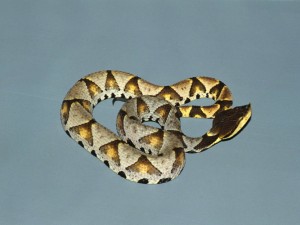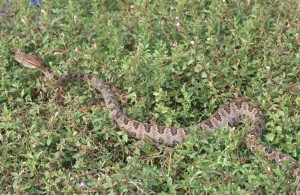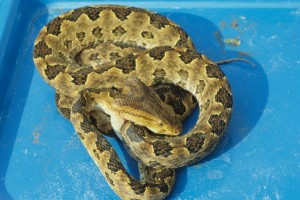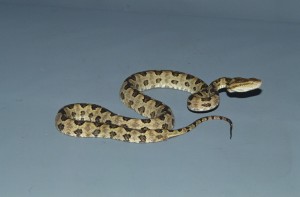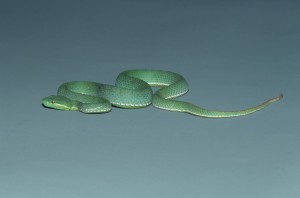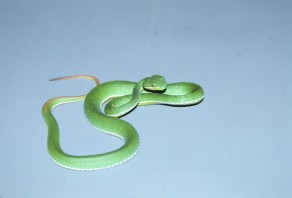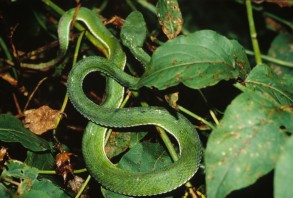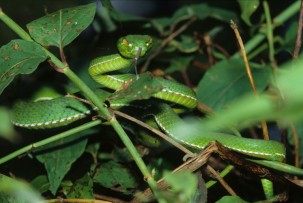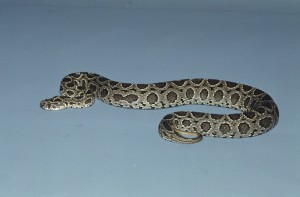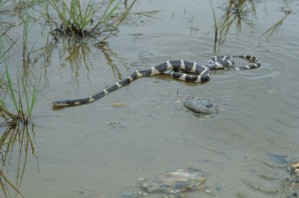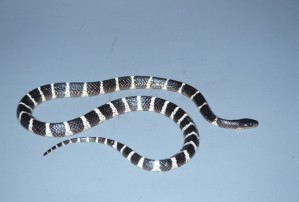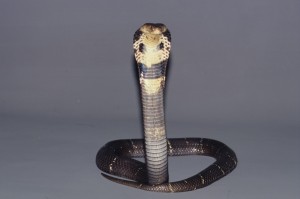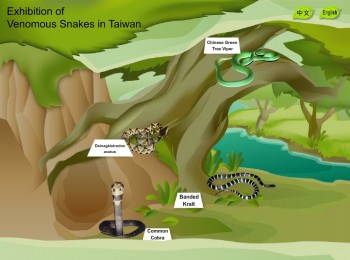TELDAP Collections
| Exhibition of Venomous Snakes in Taiwan |
|
I. The Six Common Venomous Snakes in Taiwan 1. Hundred Pacer (Deinagkistrodon acutus) A venomous snake with a potent hemotoxin. This egg-laying mid-sized snake has a short, thick body, large triangular head, thin neck and upturned snout. The top of the head is brown in color while clear triangular patterns can be seen along the sides. The belly has black spots while the tail is a black-brown color. Behavior: Active during the day and night. Usually lives at the bottom level of deciduous forests with birds and rodents making up the majority of its diet. When disturbed, it raises its head while also making a warning hissing sound and constantly waggling its tail. Distribution: Found at medium to low altitudes in broad-leaf forests, bamboo groves and river valleys throughout Hualien, Taitung, Pingtung and Kaohsiung. Bite Symptoms: Within a few minutes of the bite, the surrounding flesh dies and turns black highlighting the puncture wounds. The wound is deep with widely spaced tooth marks and quickly becomes swollen. The skin and muscle turn black from necrosis, blisters form around the tooth marks and the wound begins bleeding. The victim feels a burning pain and the size of the necrotic region depends on the amount of snake venom injected and the depth of the bite. Bite Treatment: Hundred pacer anti-venom. 2. Pointed-scaled Pit Viper (Trimeresurus mucrosquamatus) Features: A medium-sized venomous snake with a potent hemotoxin. The back is a brown or tan-brown color, with three rows of irregular dark-tan colored round patches. Behavior: Active at night. Inhabits abandoned houses and log piles. Feeds on birds, rodents, frogs and lizards. When disturbed, it raises its head and coils its body. The tail waggling restlessly is a sign that it is about to attack. Distribution: Found at low to medium altitudes in brushwood, bamboo groves, mountain gullies, river valleys and dry farmland throughout Taiwan. Bite Symptoms: Within a few minutes of the bite, the surrounding flesh dies and turns black highlighting the puncture wounds. The wound site quickly swells with the skin and muscle turning black due to necrosis. Blistering occurs and the wound bleeds continuously and feels as if it had been branded with hot irons. The size of the necrotic area depends on the amount of venom injected and the depth of the bite. Bite Treatment: Pit Viper or Green Tree Viper anti-venom. 3. Chinese Green Tree Viper (Trimeresurus stejnegeri stejnegeri) Features: A small venomous snake with a potent hemotoxin. It has a thin neck, large triangular head, green body and red eyes. There is a white or two red-white lines running along either side of the body. Due to its brick red colored tail, it's also known as the Red Tail. Behavior: Ovoviviparous, mainly active at night and is found coiled around branches in brushwood. Diet consists mainly of birds, rodents and frogs. When disturbed, it raises its head and coils its body. The tails waggling restlessly is a sign that it is about to attack. Distribution: Found at medium and low altitudes in brushwood, bamboo groves, mountain gullies, river valleys and dry farmland throughout Taiwan. Bite Symptoms: When bitten, black puncture marks can be seen. The surrounding area quickly becomes swollen, with the skin and muscle turning necrotic and blisters forming in the surroundings. The wound bleeds and feels as if on fire. Bite Treatment: Pit Viper or Green Tree Viper anti-venom. 4. Russell's Viper (Vipera russellii formosensis) Features: A medium-sized venomous snake with a toxin that is both hemorrhagic and neurotoxic. There are three rows of a chain pattern along the back made up of round patches that have a grayish-white border and brown or dark brown inside. The belly is white and covered with small black spots. Behavior: Ovoviviparous, feeds on rodents. It moves slowly with a lateral motion. When disturbed, it coils into a circle, makes a hissing sound and makes sudden strikes. Distribution: Found at medium and low altitudes in areas such as Hualien, Taitung, Kaohsiung, Pingtung and Nantou. Main habitats are mountains areas, dry farmland, river gravel and sugar cane fields. Bite Symptoms: When bitten, black puncture marks can be seen. The surrounding area quickly becomes swollen, with the skin and muscle turning necrotic and blisters forming in the surroundings. The wound bleeds. Bite Treatment: Russell's Viper anti-venom. 5. Banded Krait (Bungarus multicinctus multicinctus) Features: A snake with the most deadly neurotoxin among terrestrial venomous snakes. It is relatively placid and rarely attacks human unless wounded or threatened. The head is an oval shape while the back has a very distinctive black and white banded pattern. Behavior: Oviparous, often lives near water. Emerges at dusk and is nocturnal by preference. Feeds on other snake species, lizards, swamp eels and loaches. Distribution: Found at low altitudes in Taiwan, Kinmen and Matzu near water, rivers and ponds. Bite Treatment: Banded Krait or Common Cobra anti-venom. 6. Common Cobra (Naja naja atra) Features: A medium-to-large sized snake with neurotoxic venom. May be tan-brown, brown or dark brown in color. Those with a black belly tend to be larger in size and the head is usually oval in shape. Behavior: Oviparous, when roused, the neck spreads out so it is shaped like a spoon and makes a jet-like hissing sound. There are wide white patterns on the back with black spots inside that when expanded look as if the snake is wearing a pair of spectacles. Distribution: Found at low to medium altitudes in dry farmland, orchards and slopes with mixed brushwood throughout Taiwan. Mainly hunts during the day feeding on rodents and frogs. Bite Symptoms: The bite marks are small and shallow with a small amount of bleeding from the wound. The site quickly turns black and blisters. Bite Treatment: Banded Krait or Common Cobra anti-venom.
II. Types of Snake Venom 1) Cholinesterase: 2) L-amino acid oxidase: 3) Hyaluronidase: 4) Proteinases:
III. Snake Bite Prevention and Treatment 1. Why Do People Get Bitten by Snakes? 2. How to Prevent Snake Bites a. Near the Home: 1. Regularly clear weeds, trim bushes and sweep away fallen leaves to remove hiding places for venomous snakes. 2. Remove unnecessary timber and flowerpots so they don't provide venomous snakes with a hiding place. 3. Trim away branches and vines near the windows so snakes don't use them to crawl inside the house. 4. Fill or repair all holes and cracks in the walls or floors so venomous snakes can't get inside or hide in these places. 5. Check all vents and cover them with cloth/wire mesh to keep snakes out of the house. 6. Leftover food should be disposed of as soon as possible so it doesn't attract rodents, which in turn draw snakes into the house. 7. If there is a rodent infestation in the house, get a pest control company as soon as possible to have them removed. 8. If living in a rural area, the house should be sprayed regularly to prevent snake prey such as frogs, lizards and insects from getting inside the house. 9. Keeping livestock such as chickens, ducks, pigeons or guinea pigs may also lure snakes inside the house. 10. Regularly drain ponds and keep them clean because snakes may come to drink water or be drawn by the frogs and other animals in the pool. b. Outdoor Prevention: 1. Watch out for places frequented by venomous snakes. Keep an eye on where you are standing or sitting. 2. Wear long leather or rubber boots. 3. Wear loose pants made of dense fabric. 4. Avoid entering long grass, brushwood or overgrown rocky areas. 5. Avoid nighttime activities because this is when venomous snakes are most active. If unavoidable, use a flashlight or torch for illumination. 6. Take special care when sleeping at night because venomous snakes of the Viperidae family are drawn by body heat. 7. Avoid walking barefoot at night or without a flashlight. 8. Do not stick your hands and feet into hollow logs, holes or caves because there might be venomous snakes hiding inside. 9. When you encounter a venomous snake, stay calm and do not make any sudden movements. In such an encounter, the venomous snake is more nervous than you are, so you should stay still or withdraw slowly. Once there is sufficient space, move away. 10. Do not toy with venomous snakes as this will make them angry and increase the risk of being bitten. 11. Do not toy with or touch dead snakes. If the venomous snake is not totally dead there's a high risk of being bitten. 12. If a snake must be killed and bagged for identification purposes, wear anti-bite gloves or hook it into the bag with a long branch. 3. Treatment After a Snake Bite 9 Do's for Treating Snake Bites 1. Do stay calm: Staying calm is the golden rule for surviving a snake bite. It takes time for the venom to act. If time is wasted through panic, survival becomes doubtful. 2. Do try to suck or squeeze the venom out: The venom is a protein, so as long as there are no wounds in the mouth, it can be ingested safely. The venom should be sucked out as soon as possible. 3. Do remove jewelry or watches: The snake bite wound will start swelling so personal accessories should be removed to prevent more injury. 4. Do record the time of the bite: How quickly the wound swells is a good judge of venom quantity. 5. Do place the limbs lower than the heart: This will slow the progress of the poison. 6. Do seek medical attention as soon as possible: The only way to treat the venom is to get to a hospital as soon as possible and get an anti-venom shot. 7. Do remove the fangs from the wound as soon as possible: For neurotoxic venomous snakes such as the Banded Krait and Common Cobra, their short fangs mean that the amount of venom is directly proportional to the bite time. 8. Do remember the snake's features: If it was a venomous snake, this will allow the doctor to inject the right anti-venom and buy time for treatment. 9. Do get a rabies shot. 4. Don'ts After a Snake Bite: 1. Do not cut the bite open: Some victims of snake bites end up dying not due to the snake venom but because they cut themselves. 2. Do not use an elastic bandage: If an elastic bandage is used to limit the spread of the venom, it will merely worsen the damage in that part of the body. 3. Do not drink alcohol: Some Taiwanese people think that drinking alcohol will neutralize the venom. In fact, drinking alcohol only accelerates blood circulation and allows the venom to work faster. 4. Do not apply an ice pack: Icing only worsens the damage. A lot of patients end up having to be amputated because of ice packing.
IV. Venomous Snake Q&A Q1. What Is the Most Venomous Snake in Taiwan? Text and images are provided by National Museum of Natural Science (The Digital Museum of Nature & Culture)
|






